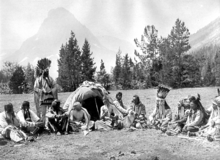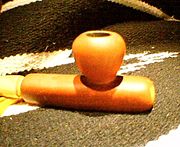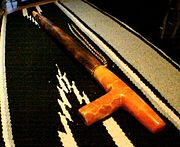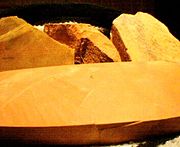- Calumet (pipe)
-
"Peace pipe" redirects here. For other uses, see Peace pipe (disambiguation).
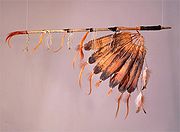 A Lakota (Sioux) chanunpa pipestem, without the pipe bowl, displayed at the United States Library of Congress
A Lakota (Sioux) chanunpa pipestem, without the pipe bowl, displayed at the United States Library of Congress
A Calumet is a ceremonial smoking pipe used by some Native American Nations. Traditionally it has been smoked to seal a covenant or treaty, or to offer prayers in a religious ceremony.
Contents
Etymology
"Calumet" is a Norman word, first recorded in David Ferrand's la Muse normande around 1625 - 1655. Its first meaning was "sort of reeds used to make pipes", with a wrong spelling for calume(l). It corresponds to the French word chalumeau 'reeds' (Modern French also 'straw', 'blowlamp'). Then, it was said by Norman-French settlers in Canada to describe the ceremonial pipes they saw in use among the First Nations people of the region.[1] The name came into English-language usage as a general term for a ceremonial pipe, though in the cultures in question it is more common for a culturally-specific term to be used.
Overview
A common material for calumet pipe bowls is red pipestone or catlinite,[2] a fine-grained easily-worked stone of a rich red color of the Coteau des Prairies, west of the Big Stone Lake in South Dakota. The pipestone quarries have traditionally been neutral ground among warring tribes, as people from multiple nations journeyed to the quarry to obtain the sacred pipestone.[2]
A type of herbal tobacco, or a mixture of herbs was usually reserved for special smoking occasions, with each region's people using the plants that were locally considered to have special qualities or a culturally condoned basis for ceremonial use.
Some northern Sioux people used long, stemmed pipes for ceremonies while others such as the Catawbas in the southeast used ceremonial pipes formed as round, footed bowls with a tubular smoke tip projecting from each cardinal direction on the bowl.
Ceremonial use
Calumets and other Native American ceremonial pipes have often been given the misnomer, "peace pipe"; this is a European construct based on only one type of pipe and one way it was used. Various types of ceremonial pipes have been used by multiple Native American cultures, with the style of pipe, materials smoked, and ceremonies being unique to the distinct religions of those Nations.
In ceremonial usage, the smoke is believed to carry prayers to the attention of the Creator or other powerful spirits. Lakota tradition has it that White Buffalo Calf Woman, brought the Chanunpa to the people, and instructed them in its symbolism and ceremonies.
According to oral traditions, and amply illustrated by pre-contact pipes in museums and tribal and private holdings, some ceremonial pipes are adorned with feathers, fur, human or animal hair, beadwork, quills, carvings or other items having significance for the owner. Other pipes are very simple. Many are not kept by an individual, but are instead held collectively by a medicine society or similar ceremonial organization.
Before the development of lighter cigarette tobacco, the smoke was too harsh to be inhaled traditionally by Native Americans in ceremonial use. Today in most peace pipe ceremonies the smoke is not inhaled.[3]
Pipestone varieties
Several Native tribes make ceremonial pipes. The types of stones used vary by tribe and locality. Some of the known types of pipe stone and pipe materials are:
Clay - The Cherokee and Chickasaw both fashioned pipes made from fired clay that also employed small reed cane pipestems made from river cane. These pipes were made from aged river clay hardened in a hot fire.
Red Pipestone - Catlinite is an iron-rich, reddish, soft quartzite slate typically excavated from below groundwater level, as the stone erodes rapidly when exposed to the weather and outside air. Red pipestone was used by the Eastern Tribes, Western and Great Basin Tribes, and the Plains Tribes, with sources of the stone in Tennessee (South Central), Minnesota (Pipestone), and Utah (Delta, Uinta). Sacred pipestone comes from Pipestone, Minnesota. The quarry itself is located just north of the town at the Pipestone National Monument. Today only people of Native American ancestry are allowed to quarry the pipestone from this quarry. The pipestone or catlinite from this quarry is softer than any other catlinite.
Blue Pipestone - Also a form of catlinite, blue pipestone was used almost predominantly by the Plains Tribes for ceremonial pipes. Deposits of the stone are also found in South Dakota. The use of blue pipestone coincided with the arrival of the horse among the Plains Tribes.
Bluestone - a hard, greenish-blue quartzite stone from the southern Appalachian Mountains. After being worked, it takes on a decidedly greenish cast. This stone was used by several Eastern Woodlands tribes for pipemaking. Cherokee, Creek, and Chickasaw made pipes from bluestone. Several ancient Mississippian bluestone pipes have been discovered.
Salmon Alabaster - the Uncompahgre Ute made beautiful ceremonial pipes from salmon alabaster mined in central Colorado.
Green Pipestone - A white on green marbled cupric pipestone found in Wyoming and South Dakota and used by the Shoshone, Ute, and Plains Tribes for personal and ceremonial pipes. This stone was also used to carve sacred effigies and religious items.
Black Pipestone (South Dakota) - a soft, brittle, white on black marbled pipestone found in South Dakota and used by the Plains Tribes for ceremonial pipes.
Black Pipestone (Uinta) - an extremely hard black quartzite slate which has undergone metamorphic compression and is found in the southeastern drainage of the Uinta Mountains in Utah and Colorado. This stone was used by the Great Basin Tribes for war clubs and beautiful pipes that are jet black with a high gloss when polished. Stones which had tumbled down creeks and drainages were always selected, since these stones typically contained no cracks or defects.
Traditional pipemaking tools
Historically, Native Americans who used the bow and arrow also employed bow drills that used hard white quartz points which, when combined with water, could bore out even the hardest of pipestones.
Early Native Americans employed moistened rawhide strips rolled in crushed white quartz and stretched with a bow handle to shape and rough the pipes. The efficiency of such bow stone saws in cutting and slabbing a large piece of red pipestone is quite surprising given their seeming simplicity. Pipes were also shaped and roughed with hard sandstones, afterward polished with water, then sanded with progressively finer and finer abrasive grit and animal hide, finally being rubbed with fat or facial oils to complete polishing.
See also
Notes
- ^ Rowland, Dunbar (1907) Encyclopedia of Mississippi History. Madison, WI: Selwyn A, Brant. p. 347
- ^ a b National Park Service. ["Error: no
|title=specified when using {{Cite web}}". [http://www.nr.nps.gov/Red%20Books/66000112.red.pdf. Retrieved September 7, 2009.[dead link] - ^ "INDIAN CALUMET: The Pipe of Peace". http://www.awarenessmag.com/julaug9/JA9_CALU.HTML.
References
 This article incorporates text from a publication now in the public domain: Chisholm, Hugh, ed (1911). Encyclopædia Britannica (11th ed.). Cambridge University Press.
This article incorporates text from a publication now in the public domain: Chisholm, Hugh, ed (1911). Encyclopædia Britannica (11th ed.). Cambridge University Press.
External links
poooo.
Categories:- NRHP articles with dead external links
- Mississippian culture
- American Indian relics
- Native American culture
- Peace symbols
- Pipe smoking
Wikimedia Foundation. 2010.


